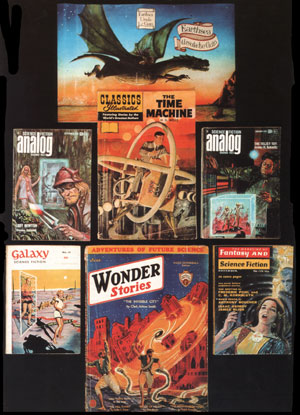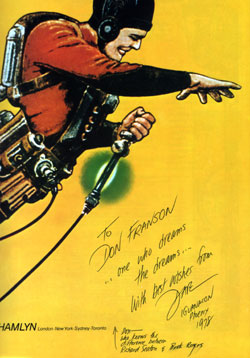The Illustrated Book of
Science Fiction Ideas & Dreams
by David Kyle
Hamlyn, London; 1977
173 pages
Voyages & cities & gadgets
The Illustrated Book of Science Fiction Ideas & Dreams is the equally excellent companion volume to David A. Kyle's earlier A Pictorial History of Science Fiction.
Like the first volume, Science Fiction Ideas & Dreams is an oversized book, thoroughly illustrated in black-and-white and color. The author here divides the field into ten chapters for basic themes: extraordinary voyages, futuristic cities, gadgets and gimmicks, and so on. Of course there is constant blurring of categories; these are not hard-edged, but allow us to get some kind of conceptual grip on the vast fluid subject of science fiction.
 Kyle constantly refers back to essential writers Jules Verne and H. G. Wells, to key editors Hugo Gernsback and John W. Campbell. But there's also a continuous delving into other highways and byways: of H.P. Lovecraft, Cordwainer Smith, Ray Cummings, Fritz Leiber, Harlan Ellison, A. Merritt, Keith Laumer, Jack Williamson, Edward E. Smith, Ursula K. Le Guin, Edgar Rice Burroughs, Andre Norton and many more. The interplay among all these editors, writers, and artists makes up the fascinating texture of these ten themes that Kyle lays out before us.
Kyle constantly refers back to essential writers Jules Verne and H. G. Wells, to key editors Hugo Gernsback and John W. Campbell. But there's also a continuous delving into other highways and byways: of H.P. Lovecraft, Cordwainer Smith, Ray Cummings, Fritz Leiber, Harlan Ellison, A. Merritt, Keith Laumer, Jack Williamson, Edward E. Smith, Ursula K. Le Guin, Edgar Rice Burroughs, Andre Norton and many more. The interplay among all these editors, writers, and artists makes up the fascinating texture of these ten themes that Kyle lays out before us.
The wonderful color covers and interior black-and-white illustrations that are reproduced are sparkling invitations from the artists to explore further in the writers' strange realms. Artists such as Frank R. Paul and Kelly Freas to Wesso and Dold and many more enliven the pages.
Stepping away for perspective, Kyle occasionally quotes or argues with one or another of the critics also, from Kingsley Amis to Damon Knight.
A nice contrast of Verne and Wells:
Verne's world capital city had rolling pavements and electrically lighted advertising projections; and so had Wells with his 'traveling platforms' in "A Story of the Days to Come", the originals for sf's 'slideways', 'beltways', 'pedwalks', etc., most of which have come into existence in real life. The logical extension to this kind of transportation is Robert A. Heinlein's "The Roads Must Roll" in 1940, in which giant conveyor belts connect his Road Cities. Even whole cities now are mobile by further extension of this idea.
As the world moved into the twentieth century, so did science fiction, not superficially, but at its heart. Wells lived halfway into this century, but his scientific romances were almost all written within a span of about ten years at the turn of the past century. Verne could be called the father of technological science fiction; Wells deserves the accolade of the father of philosophical science fiction. In contrast to Verne, who was meticulous in reporting every scientific fact which he thought would make his story logical and believable and who usually based his fiction on inventions and discoveries which were actually on the verge of happening — in contrast, Wells used reasoned argument rather than laboratory documentation. The adroitness with which he developed his premise is a model for every sf writer. This is shown in the beginning of his first, and perhaps greatest, story, The Time Machine (1895). The Time Traveller asks the question, 'Can an instantaneous cube exist?' ...
These contrasts still affect science fiction. More importantly, how these strands are mixed in all of us arguably affect how we see the world, how we reason and feel, and how we interact with the world as we see it — and the future as we hope or dread.
 This illustration detail from Frank R. Paul's cover of Amazing Stories for August 1928 [click to enlarge] is reproduced on the title page of Science Fiction Ideas & Dreams, showing Richard Seaton with his flying belt — as discussed in Donald L. Franson's Amazing Stories, 1926-1995: An Obituary, with an Aside on Buck Rogers. David Kyle, like my uncle, finds an interesting point here.
This illustration detail from Frank R. Paul's cover of Amazing Stories for August 1928 [click to enlarge] is reproduced on the title page of Science Fiction Ideas & Dreams, showing Richard Seaton with his flying belt — as discussed in Donald L. Franson's Amazing Stories, 1926-1995: An Obituary, with an Aside on Buck Rogers. David Kyle, like my uncle, finds an interesting point here.
I'll put it to you this way: an early confusion connected with this issue of Amazing Stories created a tiny fork in our zone of the timeline, in the universe's spatio-temporal garden of forking paths. Taking the other path with the correct inference about this picture back then, we may have found ourselves on another, superficially very similar timeline — but living in an alternate world in which the glorious visionary science-fiction novelist Edward E. Smith was far more prominent.
By the late 1930s this single fact could have changed the whole world's understanding of science fiction — to say the least. I cannot begin to tell you.
Back to the book at hand, in our currently-accepted timeline ... It's not possible to cover all of the all-encompassing field of science fiction, which not only makes a grab at understanding the Cosmic All, but continuously is transforming itself even as it looks forward, backward, sidewise and every other way we can think of or dream. But David Kyle shares his wonder and joy and deep appreciation here.
If after a session in his book, you want to look up an old science fiction story, or search for one that you haven't seen yet, he's been well justified in writing this survey. You may find that the Weird, Amazing, and Astounding highlights in The Illustrated Book of Science Fiction Ideas & Dreams itself stretch your imagination a bit, toss a few new-to-you ideas into your head, perhaps even lift your own feelings or charm your dreams.
© 2003 Robert Wilfred Franson
DLF facilitated this.
ReFuture at Troynovant
history of science fiction
& progress of fantasy
| Troynovant, or Renewing Troy: | New | Contents | |||
| recurrent inspiration | Recent Updates | |||
|
www.Troynovant.com |
||||
|
Reviews |
||||
| Strata | Regions | Personae |
|
|||